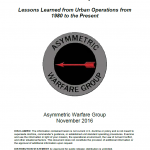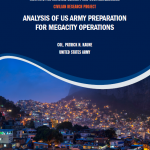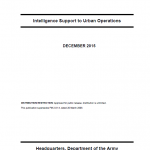With the continuing growth in the world’s urban areas and increasing population concentrations in urban areas, the probability that the US Army will conduct full spectrum operations in urban environments is ever more likely. As urbanization has changed the demographic landscape, potential enemies recognize the inherent danger and complexity of this environment to the attacker, and may view it as their best chance to negate the technological and firepower advantages of modernized opponents. Given the global population trends and the likely strategies and tactics of future threats, Army forces will likely conduct operations in, around, and over urban areas—not as a matter of fate, but as a deliberate choice linked to national security objectives and strategy. Stability operations––where keeping the social structure, economic structure, and political support institutions intact and functioning or having to almost simultaneously provide the services associated with those structures and institutions is the primary mission––may dominate urban operations. This requires specific and timely intelligence support, placing a tremendous demand on the Intelligence warfighting functions for operations, short-term planning, and long-term planning.
Read more →



